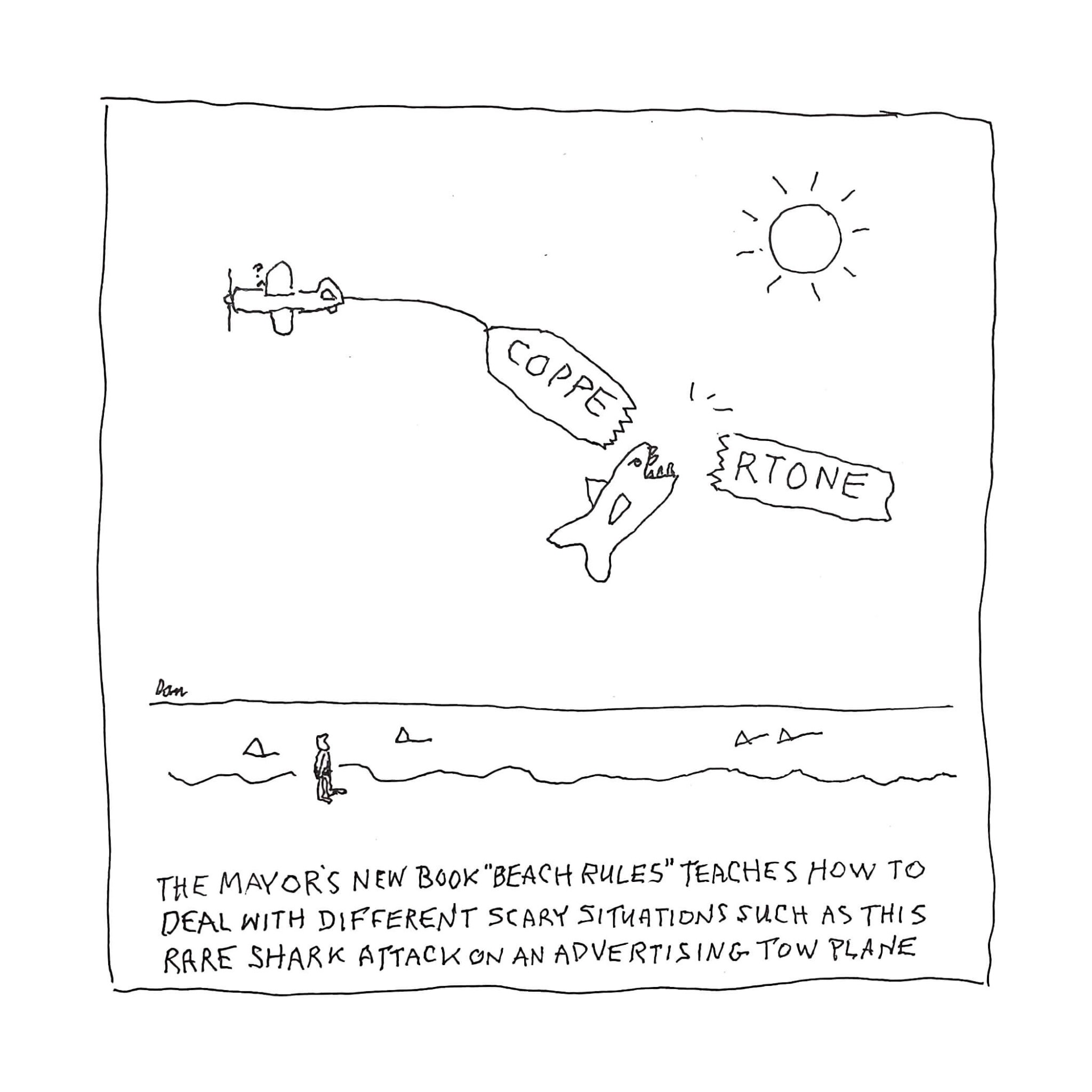Ocean Rules to Live By

When it became apparent last summer that fewer people went ocean swimming here because of one fear or another, Hampton Town Mayor Madeline McKracken decided that for 2023 she would have the town publish a booklet titled “Ocean Rules.”
This past April, the research company AI Environment Solutions was hired to complete the task by June 15, but because of cost overruns, the mayor didn’t receive the booklet until September 10. So here it is. There are still a few weeks left in the swimming season. Use it well. And hang onto it for swimming here in 2024.
OCEAN RULES
Afraid of the ocean? This booklet will tell you what you can do to make your summer safe.
SHARKS
Yes, there are more sharks in the ocean than ever. It’s because environmentalists are now saving the tiny menhaden fish from extinction. Sharks consider menhaden a delicacy, so when they chase what is now an infestation of menhaden fish to the shoreline, they feast on them excitedly. Sometimes, in error, the sharks bite a human.
When you see a shark fin while swimming, get yourself behind someone closer to the shark heading your way. Then hold perfectly still. Menhaden attract the sharks by wriggling while trying to get away. Stand your ground. Wait for a lifeguard to whistle the all clear. Then continue on.
FLOATING TRASH
As you may know, there is an island of floating trash larger than Greenland moseying around in the Atlantic Ocean. Nobody can do anything about it. But so far, it has not drifted ashore in the Hamptons. As long as it doesn’t do that, breathe easy. But keep an eye out for it. And if you see Clorox bottles or plastic furniture or empty Coca-Cola bottles floating in toward Quogue or someplace, run and tell the lifeguard about it. He’ll know what to do.
HALF-HOUR RULE
In the 1960s, mothers didn’t let their children swim in the ocean until half an hour after eating. It was feared that swimming on a full stomach might cause cramps. In the 1990s, however, scientists said this was hogwash. Swim right after eating, no problem.
Now, 30 years later, new studies show those long-ago mothers were right. Swimming less than half an hour after eating causes stroke, heart attacks, strangulation, palpitations, gastroesophageal reflux disease (GERD), heavy breathing, the sudden growth of serious tumors, gas and life-threatening cramps, which are up 11%. It really is an alarming situation. Be sure children younger than the age of 12 obey this rule.
RIP CURRENTS
Experts say that something called a rip current can drag people out to sea without their consent. What causes this is not known. But it happens. So if you see this happening — the ocean surf will turn a fluorescent purple color and swirl around while grabbing your ankles to cast you out — be aware that there’s a spray currently in testing that will stop this from happening.
When it’s approved by the Food and Drug Administration, you should get some. Until then, get a can in a dark alley somewhere, hide it in the bottom of your beach bag wrapped in, for example, a copy of Dan’s Papers, and use it when necessary.
It’s called Alliehexadine Bopmundjo Bonjohnicain 0.8 and comes as a cream, ointment or paste. The paste is best. Lather it on liberally or, if you are not that, conservatively.
SANDFLIES
Sandflies are attracted to bare skin, so always wear thick clothing and buckle up when at the beach. You can also arm yourself with the latest new anti-fly gadget — little tiny 6-inch-long fly swatters that are sold in packets of 100 at pharmacies everywhere. And you can throw them in the sand after use. They are completely biodegradable.
PORTUGUESE MAN O’ WAR
Poisonous Portuguese man o’ war have been found on Hampton beaches. Until now, they had only been found on beaches in the South. But global warming has caused them to migrate north. They are football-sized blue opaque balloons with tentacles on the bottom. And if you step on one, it will pop and as a death rattle emit an extremely painful poisonous goo. Walking the beaches, always look down. Step sideways and around when you see one.
You can save yourself by injecting yourself with an EpiPen within 10 seconds after the encounter.
WHALE ASHORE
Sometimes, giant 100-ton whales, particularly sick ones, get driven ashore to die on the sand. It’s easy to see one coming in the daytime, but at night it could be a problem. Stay alert. Don’t get flattened.
SUNBURN
Sunburn can be prevented by applying SPF 50-plus sunscreen on all the exposed parts of your body before lying down and sleeping on a blanket in the daytime on the beach.
If you are a Caucasian, (a white person), always go to the beach with a friend who can wake you up if they see your skin turning an angry bright red. As for people of color, it’s harder to tell, so always wear a wristwatch that has an alarm and don’t sleep more than 30 minutes at a time. Indeed, 15 minutes in the sun is good for you no matter what color your skin is. You get a day’s worth of vitamin D for every 15 minutes that you lie in the sun.
LOW-FLYING PLANES
Wealthy people flying to the Hamptons in noisy private aircraft spend a lot of money and so are allowed to fly as high or low over the beach as they want. It’s up to them and there’s nothing you can do about it. So get used to it.
HAPPY BIRTHDAY BALLOONS
It’s easy to trip over these things as their helium escapes and they come down at the beach far from the party they escaped from. Always watch where you are going, particularly at night, so you don’t hurt yourself.
PIPING PLOVERS
Between April and August, many beaches here are roped off to keep humans from tromping on piping plover nests. Piping plover birds became a protected species under the Endangered Species Act on January 10, 1986 and now their numbers have increased dramatically.
Early on, the plovers relied on the roped-off areas for safety. But now they’ve taken matters into their own hands and will dive-bomb and peck at you if you venture close. Nothing can be done. Just stay away from the nests.
Happy ocean swimming!



